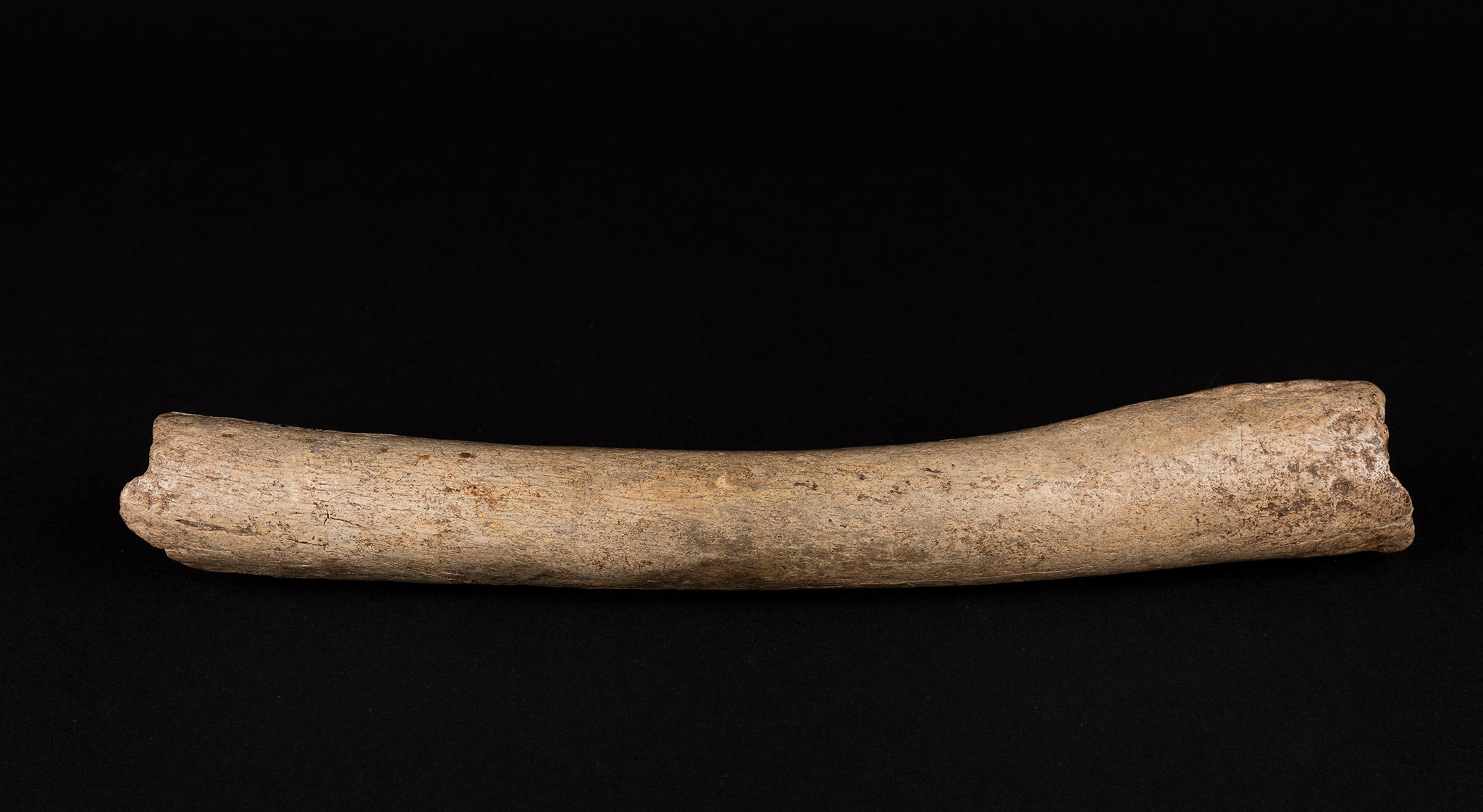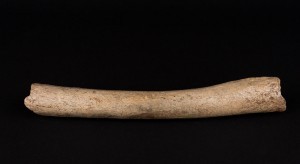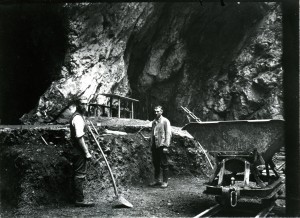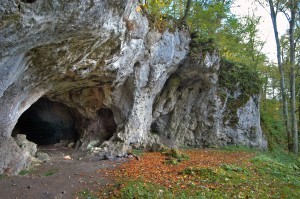With fossils and DNA, scientists are piecing together a picture of humanity’s beginnings, an origin story with more twists than anything you would find at the movie theater.
The expert consensus now is that Homo sapiens evolved at least 300,000 years ago in Africa. Only much later — roughly 70,000 years ago — did a small group of Africans establish themselves on other continents, giving rise to other populations of people today.
To Johannes Krause, the director of the Max Planck Institute for Human History in Germany, that gap seems peculiar. “Why did people not leave Africa before?” he asked in an interview. After all, he observed, the continent is physically linked to the Near East. “You could have just walked out.”
In a study published Tuesday in Nature Communications, Dr. Krause and his colleagues report that Africans did indeed walk out — over 270,000 years ago.
(Part of a femur, or thigh bone, from a Neanderthal that was discovered in the Hohlenstein-Stadel cave in Germany)
Based on newly discovered DNA in fossils, the researchers conclude that a wave of early Homo sapiens, or close relatives of our species, made their way from Africa to Europe. There, they interbred with Neanderthals.
Then the ancient African migrants disappeared. But some of their DNA endured in later generations of Neanderthals.
“This is now a comprehensive picture,” Dr. Krause said. “It brings everything together.”
Since the 1800s, paleontologists have struggled to understand how Neanderthals are related to us. Fossils show that they were anatomically distinct, with a heavy brow, a stout body and a number of subtler features that we lack.
The oldest bones of Neanderthal-like individuals, found in a Spanish cave called Sima de los Huesos, date back 430,000 years. More recent Neanderthal remains, dating to about 100,000 years ago, can be found across Europe and all the way to southern Siberia.
Then, 40,000 years ago, Neanderthals vanish from the fossil record.
As a graduate student in the mid-2000s, Dr. Krause traveled to museums to drill bits of bone from Neanderthal fossils. In some of them, he and his colleagues managed to find fragments of DNA that they could study.
(Excavations at the entrance of the Hohlenstein-Stadel cave in 1937, the year when the Neanderthal femur was found)
Scientists who study ancient genes search for two kinds of genetic material. The vast majority of our genes are in a pouch in each cell called the nucleus. We inherit so-called nuclear DNA from both parents.
But we also carry a small amount of DNA in the fuel-generating factories of our cells, called mitochondria. We inherit mitochondrial DNA only from our mothers, because a father’s sperm destroys its own mitochondrial DNA during fertilization.
Years ago, Dr. Krause and his colleagues started their search for ancient Neanderthal genes in a fossil by looking for mitochondrial DNA. After discovering mitochondrial DNA in some fossils, they later managed to find nuclear DNA.
The genes held some surprises. For example, bits of DNA in living people of non-African ancestry come from Neanderthals. When modern humans expanded out of Africa, they seem to have interbred several times with Neanderthals.
Those children became part of human society, passing on their genes.
But a finger bone and a tooth from a Siberian cave called Denisova left Dr. Krause and his colleagues with a baffling puzzle.
Inside those fossils, the scientists found sequences of mitochondrial DNA that were not human or Neanderthal, but something else — a distant branch of the family tree. The Neanderthal mitochondrial DNA was much closer to our own.
Later, the researchers managed to recover the nuclear DNA from the Denisovan finger bone, which showed Denisovans and Neanderthals were more closely related to each other.
As scientists found ancient DNA in more fossils, our history has come into sharper focus. Scientists now estimate that the common ancestor of modern humans, Neanderthals and Denisovans, lived between 765,000 and 550,000 years ago.
About 445,000 to 473,000 years ago, that common ancestor’s descendants split into two lineages. One eventually led to modern humans, while the other led to Neanderthals and Denisovans.
After years of investigation, however, Dr. Krause still did not understand why the nuclear DNA and mitochondrial DNA of Neanderthals seemed to have different histories. The former pointed to a link with Denisovans, the latter to humans.
(The entrance to the Hohlenstein-Stadel cave seen recently. In 2013, a researcher examined a Neanderthal fossil from the cave and was able to reconstruct all of its mitochondrial DNA)
The mystery only deepened in 2013. Another team of researchers retrieved mitochondrial DNA from a Neanderthal-like fossil at Sima de los Huesos, dating back 430,000 years.
The researchers had expected the DNA to resemble that of later Neanderthals in Europe. Instead, the mitochondrial DNA looked like it belonged to Denisovans — even though the Denisova cave was 4,000 miles away in Siberia.
Last year, the researchers announced they had gathered a small fraction of the nuclear DNA from the same Sima de los Huesos fossil. That genetic material looked like it belonged to a Neanderthal, not a Denisovan.
Dr. Krause and his colleagues have now discovered new Neanderthal DNA that they believe can solve the mystery of this genetic mismatch.
In 2013, one of Dr. Krause’s graduate students, Cosimo Posth, examined a Neanderthal fossil from a German cave called Hohlenstein-Stadel. He was able to reconstruct all of its mitochondrial DNA.
Dr. Posth estimated that the Neanderthal fossil was 120,000 years old and, more important, that it belonged to a branch of the Neanderthal family tree with a long history. He and his colleagues determined that all known Neanderthals inherited their mitochondrial DNA from an ancestor who lived 270,000 years ago.
All the data pointed to a sequence of events that could solve the puzzle that had bedeviled Dr. Krause for so long.
The common ancestors of Neanderthals and Denisovans spread across Europe and Asia over half a million years ago. Gradually the eastern and western populations parted ways, genetically speaking.
In the east, they became Denisovans. In the west, they became Neanderthals. The 430,000-year-old fossils at Sima de los Huesos — Neanderthals with Denisovanlike genes — capture the early stage of that split.
At some point before 270,000 years ago, African humans closely related to us moved into Europe and interbred with Neanderthals. Their DNA entered the Neanderthal gene pool.
Over many generations, most of that new DNA disappeared. But the mitochondrial DNA survived, passed down from mothers to their children. In fact, eventually all the Neanderthals inherited it, for some reason discarding the mitochondrial DNA that the species once had.
Dr. Posth said it was possible that early members of our own species moved from North Africa into Europe. Supporting this idea was the discovery reported last month of fossils of Homo sapiens in Morocco dating back 300,000 years.
But Dr. Posth said it was too soon to rule out another possibility: that these migrants belonged to another species in Africa closely related to us that scientists have yet to document.
“I feel uncomfortable to give a name to these humans,” Dr. Posth said.
Adam C. Siepel, a geneticist at Cold Spring Harbor Laboratory on Long Island who was not involved in the new study, said the hypothesis fit the evidence. “I think that’s absolutely possible,” he said.
The new study raises a host of tantalizing implications about human history.
It is not possible to know just how many times these early Africans interbred with Neanderthals. But somewhere in prehistory, at least one female human from Africa must have carried the child of a male Neanderthal.
“Now you have this hybrid child, which is probably pretty unusual-looking,” Dr. Siepel said. “One way or another, this hybrid individual was absorbed into Neanderthal society.”
Dr. Siepel warned that the hypothesis hinges on the new DNA found in the Hohlenstein-Stadel fossil. Dr. Krause and his colleagues are now trying to retrieve nuclear DNA from the fossil.
The research at Sima de los Huesos shows just how far back in time scientists can now search for genes. The most revealing DNA might come from the mountains of Morocco.
There, scientists may be able to find genes from the earliest Homo sapiens, which they can then compare to Neanderthals’.
“These are things that I never thought possible five years ago,” Dr. Krause said.
Source: www.nytimes.com
Ask me anything
Explore related questions








